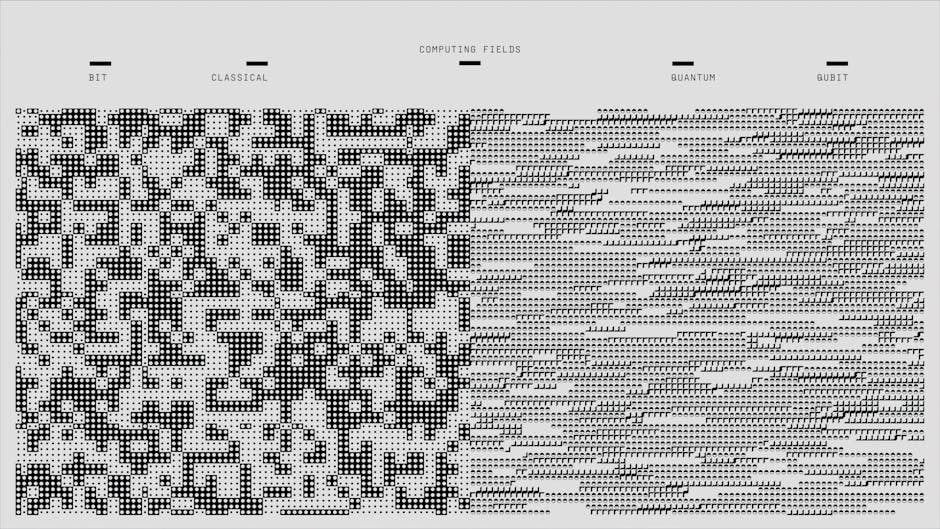What Is Quantum Computing, Really?
Quantum computing isn’t just an upgrade of classical computing—it’s a fundamentally different model of information processing. To understand the opportunity, you have to grasp what makes quantum unique.
Qubits vs. Classical Bits
At the heart of every computer are bits. In classical computing, each bit is either a 0 or a 1—simple, binary, and predictable.
Quantum computers use qubits (quantum bits), which are far more complex:
– Superposition: A qubit can be both 0 and 1 at the same time, in varying probabilities. This allows quantum systems to explore multiple outcomes simultaneously.
– Entanglement: Qubits can be linked in such a way that the state of one instantly affects the state of another, no matter the distance. This enables powerful coordination between qubits.
– Interference and Quantum Gates: Quantum logic operations manipulate the probability amplitudes of qubit states. Quantum gates replace classical logic gates and drive the behavior of quantum algorithms.
Why It’s Different (And Not Just Faster)
Quantum computing doesn’t just accelerate existing tasks—it tackles problems that are nearly impossible for classical machines. Rather than processing data in a linear, step-by-step fashion, quantum computers can analyze vast possibilities in parallel.
This means they’re uniquely suitable for tasks like:
– Factoring large numbers (relevant for cryptography)
– Simulating complex molecular structures
– Optimizing massive variable systems (like logistics or portfolios)
These aren’t speed gains—they’re entirely new methods of solving problems.
Key Concepts You Should Know
Before diving into applications, it’s essential to anchor yourself in some foundational ideas:
– Superposition: Enables parallelism
– Entanglement: Enables correlation between qubits
– Quantum Gates: Control how qubits change states, forming the basis of quantum algorithms
Understanding these core ideas helps demystify quantum computing and opens the door to practical insights as the technology matures.
Why Quantum Matters Now
Quantum computing has spent decades in the lab, but that phase is ending. Hardware is finally catching up to the theory. Qubits are getting more stable, error rates are shrinking, and quantum processors are scaling. It’s no longer science fiction—it’s engineering. Companies like IBM and Rigetti are putting real machines online, while startups are pushing innovations in qubit design, cooling systems, and coherence times. We’re not at mainstream adoption, but we’re clearly past the “just promise” stage.
The talent surge is real, too. Universities are spinning up quantum programs, and physicists are pivoting to industry in large numbers. Venture capital is flowing, fast—nearly doubling year-over-year in some regions. Quantum engineers, software developers, applied physicists—these roles are in demand, and salaries are reflecting that.
Then there’s the bigger buy-in. Governments aren’t sitting this one out. The U.S., China, and the EU are all investing billions, eyeing national security, economic advantage, and scientific leadership. Big tech is all-in as well. Google’s quantum AI division isn’t just an R&D curiosity—it’s a long-game bet.
Add it all up, and you’ve got a rare tech moment: deep science merging with market momentum. For businesses, builders, and policymakers, this is a shift worth taking seriously.
Opportunity Zones: Where Quantum Can Win First
Cybersecurity
Quantum computing puts a ticking clock on today’s encryption. Algorithms like RSA and ECC, which protect everything from emails to banking sessions, weren’t built to survive a world where quantum can brute-force through keys in minutes. This is why researchers and standards bodies are racing to finalize post-quantum cryptography (PQC)—encryption techniques that could withstand both classical and quantum attacks. The threat isn’t hypothetical anymore; it’s a matter of when, not if. Every secure system built today must be ready for a quantum tomorrow.
Quantum-safe communication systems are also under active development. Think of secure messaging apps, VPNs, and critical infrastructure protocols being redesigned from the ground up. Some organizations are experimenting with quantum key distribution (QKD), a new way to send ultra-secure messages using principles of quantum physics. It’s not scalable yet, but it’s a peek at how tomorrow’s secure networks might operate.
Pharmaceuticals
When you simulate how a molecule behaves at the quantum level, you get better answers. Classical computers simplify this math—but oversimplify it. Quantum computers don’t have to. That means drug discovery processes, which currently take years and billions, could be cut down dramatically. In 2024, companies are starting to run early experiments, simulating complex interactions that were only theoretical a few years ago.
The goal isn’t just speed—it’s precision. Faster targeting, custom compounds, and quicker testing cycles could change how medication is developed, especially for diseases we still don’t fully understand.
Finance
Finance is all about managing uncertainty. Portfolio optimization, derivatives pricing, and risk modeling run on algorithms that strain even the best classical hardware. Quantum systems promise better answers, faster, by sifting through massive variables in parallel.
Quantum computing won’t replace Bloomberg terminals overnight. But hedge funds, banks, and fintech players are already testing quantum’s edge in portfolio optimization. Speed isn’t the only win—better forecasting and smarter modeling could alter the financial landscape fundamentally.
Manufacturing & Logistics
Quantum has the potential to reshape how goods are made and moved. From optimizing factory line setups to untangling global delivery networks, the math underneath these logistics problems is brutal—and ideal for quantum algorithms. Early-stage quantum simulations are helping companies minimize waste, reduce downtime, and maximize output, especially under unpredictable global conditions.
Imagine shaving 6% off your input materials or cutting shipping delays by optimizing thousands of routes at once. Small gains at global scale equal big savings.
Bonus: Blockchain Integration
Blockchain’s security model also faces pressure. The core math behind public/private key systems is vulnerable in a post-quantum world. As more assets, contracts, and identities move onto blockchains, there’s a growing push to build quantum-resistant protocols.
Some projects are experimenting with lattice-based cryptography and hybrid models to maintain decentralization without exposing networks to future attacks. The transition won’t be overnight, but the clock is ticking.
Related reading: Blockchain’s Move Beyond Cryptocurrency
Roadblocks and Reality Checks
Quantum computing sounds like magic, but the hardware is still rough around the edges. Qubits are fragile. They don’t like noise, they make errors often, and they demand near-zero temperatures to function. That’s not exactly plug-and-play. Right now, keeping a quantum machine stable takes a lot of infrastructure—and even more patience.
Algorithms aren’t much further ahead. Most quantum algorithms today are highly specialized, designed for narrow tasks by researchers deep in the weeds. We’re not at the point where you can download a quantum version of Excel or Photoshop. Real-world use cases are coming, but we’re still talking more experiment than utility.
Then there’s the talent issue. Quantum developers don’t grow on trees. It takes a rare mix of physics, math, and computer science to build or even use these systems. Finding that blend is tough. Training new talent takes time, and today, companies are often poaching from the same small pool of experts.
Bottom line: the potential is massive, but this space is still rugged and early. If you’re diving in, be ready to get your hands dirty.
What Companies and Builders Should Do Now
You don’t have to be a quantum expert to prepare for a quantum world. But you do need to start watching for signs of readiness in your industry. Who’s hiring quantum talent? Who’s building prototypes? Who’s filing patents? Knowing where your field stands gives you context—and a head start.
Begin small. Pilot projects are a smart way in. One internal test, one academic partnership, one roundtable with a quantum startup—that’s enough to start building muscle. If your team doesn’t know quantum from quicksand, consider internal education. Lunch-and-learns, short courses, and tech briefings can go a long way.
And no, the tech isn’t perfect yet. That’s irrelevant. If you wait for a paint-by-numbers roadmap, you’ll be late. The companies that win in this space are the ones that experiment early, learn fast, and stay nimble. Timing will matter more than certainty.
Looking Ahead
Quantum computing isn’t going to reshuffle the tech landscape overnight—but the window for real commercial impact is no longer a vague ‘someday.’ Most experts expect meaningful applications to start emerging within 3 to 5 years, especially in areas like optimization and simulation. It’s not about replacing classical computing. It’s about tackling problems so complex they’ve been untouchable until now.
The big players are already elbow-deep. IBM has its Quantum System One in deployment and is rolling out a roadmap with practical, scalable systems. Google shook headlines with its quantum supremacy claim and continues pushing forward with heavy R&D. Then there are startups—Rigetti, IonQ, PsiQuantum—each carving out slices of the ecosystem, often with a narrower but well-defined focus. Outside the U.S., research labs in China, Germany, and Canada are also advancing fast, often backed by deep public funding.
Here’s the truth: we’re in a pre-industrial phase of quantum. Still raw, still noisy—but rapidly evolving. Classical computing isn’t going anywhere. But when quantum hits its stride, it won’t just add power—it’ll expand the map. For industries wrestling with the impossible, this is the tech that could redraw the boundaries.


 Ezarynna Flintfield is the co-founder of wbsoftwarement where she leads the platform’s mission to explore the future of software innovation. With expertise in digital strategy, AI, and cybersecurity, Ezarynna shares deep insights on how technology continues to transform businesses and everyday life. Her forward-thinking approach inspires both professionals and learners in the tech community.
Ezarynna Flintfield is the co-founder of wbsoftwarement where she leads the platform’s mission to explore the future of software innovation. With expertise in digital strategy, AI, and cybersecurity, Ezarynna shares deep insights on how technology continues to transform businesses and everyday life. Her forward-thinking approach inspires both professionals and learners in the tech community.

